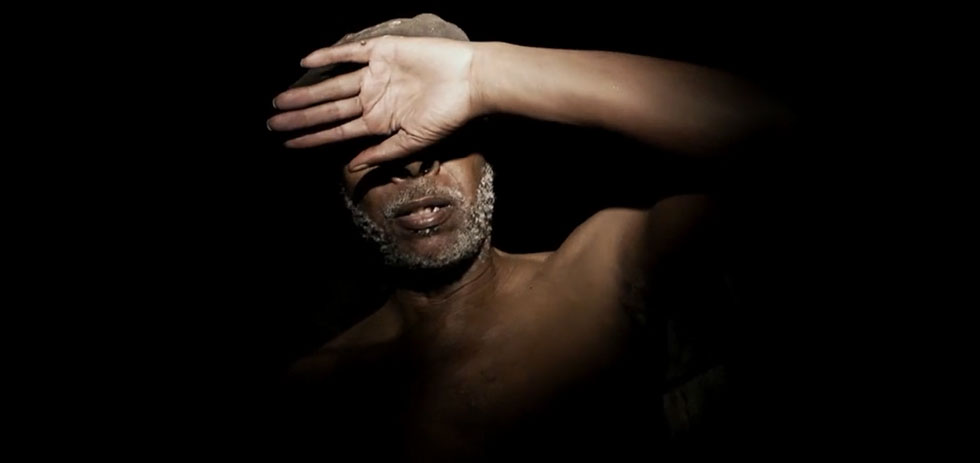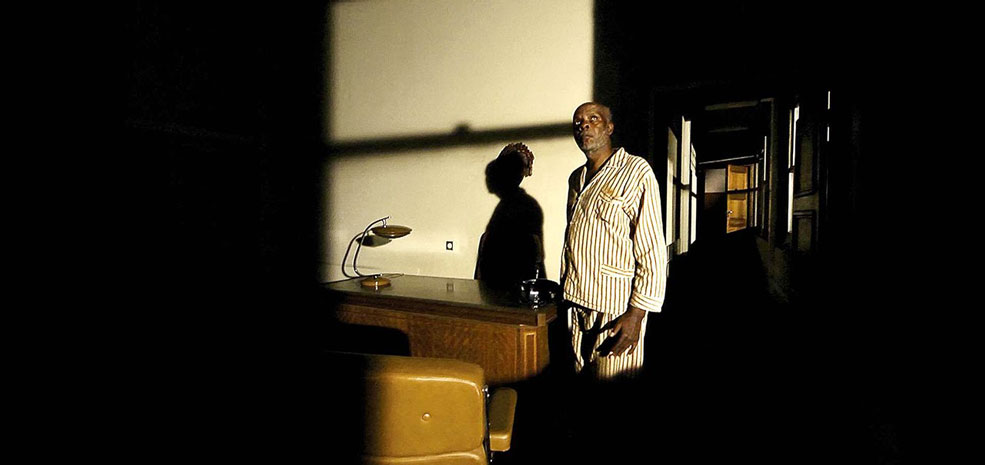Even amongst the diverse field of entries at this year’s Melbourne International Film Festival, Horse Money remains a unique experience. Though director Pedro Costa has made no secret of his key influences over the years,1 it struck me as the film at the festival that most closely reflected a director working through a very personal set of aesthetic and philosophical pre-occupations on filmmaking. While those who have followed Costa over the years will note a level of continuity with his previous films, both in casting and in terms of the broad subjects that he tackles, Horse Money also presents us with a few key departures that testify to the evolving nature of his work.
Given the particular nature of Horse Money, it is worth reflecting on Pedro Costa’s career in order to better understand the film and the challenges it offers its viewer. Over the years, it seems that the Portuguese director’s craft has developed into its current, singular form through several incremental shifts in approach, with each new film developing on a discovery forged in the last. These discoveries have been both technological (a switch to digital in the early 2000s), and also related to questions of aesthetics and attitude (the approach to the subject); often, as in In Vanda’s Room, the two are closely interrelated. After his first two features, which exhibited a cinephile’s background in their indebtedness to the films of Jacques Tourneur, Nicholas Ray and Robert Bresson,2 his next three narrative features saw the director carve out a unique voice through his stark depiction of Fontainhas, a poor neighbourhood in Lisbon from which Costa plucked a handful of residents to star in his films. Amongst other things, the “trilogy” presented a fascinating array of approaches to representing similar subjects and situations: Bones (1997) was a bare-bones though comparatively conventional social drama; In Vanda’s Room (2000) a hyper-realist, low-budget blend of document and fiction; while Colossal Youth (2006) took the primacy of the performer and the long take of Vanda to more poetic ends in its sketch of dislocated peoples.
These narrative features, along with the two documentaries Costa directed on filmmakers Jean-Marie Straub and Danièle Huillet as well as on French singer Jeanne Balibar, showed that along with an adherence to a certain conception of cinematic realism,3, portraiture (as Jonathan Rosenbaum has called it)4 is key to the director’s work. Especially starting with the Fontainhas films, Costa’s attention to his leading men and women, whether it be to the way they speak or how they move, finds few equals in terms of the intensity of the portrayals and the intimate proximity in which we as spectators are placed to them. Horse Money is primarily a portrait of Ventura, the lead in Costa’s previous narrative feature Colossal Youth, though the presence of Vitalina (Vitalina Virela, a real-life relative of Ventura’s) is no less important in the film’s first half. Through the reflections of these characters on their pasts,5 Costa builds a dense and often opaque work on Portugal’s colonial history and its effects on the diaspora from its ex-colonies living in Portugal.
In Horse Money, Costa’s approach to narrative reaches a level of abstraction that is new in his work. While narrative ellipses are a feature of almost all of his fiction films, particularly Colossal Youth, here they are so prevalent as to almost entirely muddy up the linkages that connect each sequence to the one preceding it. It’s tempting, then, to treat the film as a series of discrete sequences that have Ventura as their unifying factor; our protagonist drifts through the film encountering people and memories from his past in a fashion that appears to have little to do with the tide of cause and effect. The film’s visual organisation mimics the looseness of its narrative, blurring the principles that classically structure space and temporality. Characters find themselves largely in half-built (or half-dilapidated) institutional spaces; remnants of hospitals, prisons and factories whose functional qualities have been stripped away by decay. Establishing shots are rare, with characters often framed in exquisite enveloping darkness that shows just a hint of abandoned rooms and corridors around them.

Time as well is warped, the film slipping between past and present with none of the markers we associate with these shifts.6 It is above all Ventura’s dialogue and actions that contribute to this vertiginous feeling of atemporality. At several moments in the film he seems to slip into reverie, claiming that he is seventeen and explaining to his boss that he is ready to work. In another scene, he wanders through an abandoned factory, picks up a clearly disconnected phone and tries to talk to his boss to resolve a payment dispute. Vitalina, on the other hand, reads out her birth certificate with a feverish intensity. That all these memories refer to very concrete, even banal moments in the past (bureaucracy is a surprisingly prevalent theme that connects them) makes their inclusion in the form of repeated snippets of dialogue all the more surprising though no less affecting.
In this obsession with memory and the texture of the past, it seems to me to that Ventura and Vitalina figure more than any other characters in Costa’s work as conduits for the experiences of others. Without losing the intense focus on his characters and what makes them singular, Costa ties a heightened focus on individual subjectivity with a collective experience of memory.7. This is hinted at in the striking opening that features a montage of black and white photographs by Danish photographer Jacob Riis of early 20th century New York tenement buildings and their occupants. It’s a singular moment in the director’s work in that there is a purely archival piece placed in the film, a connection to history through someone else’s representation.8. The photos come from a completely separate time and place, though one could easily draw parallels between migrants in poor housing conditions in that context to that of Horse Money and the Fontainhas cycle. There’s a similar effect created by a sequence at the film’s halfway point where Costa breaks from the focus on Ventura and Vitalina to cut together a series of shots of residents in the neighbourhood. Backed by the film’s only piece of non-diegetic music, the sequence gives us a brief moment of pause from the main characters’ hushed incantations to open out onto a series of portraits within the neighbourhood of other migrants. As with the photographs placed at the start of the film, these sequences takes us away from our protagonists long enough to encourage us to place their story within a broader set of experiences.
The justifiably much talked-about, 15-minute elevator sequence just before the film’s close brings many of these preoccupations about personal and cultural memory into relief in a striking fashion. In it, Ventura stands next to a soldier from the days of the Portuguese Carnation Revolution dressed in full camouflage, face painted and still as a statue. What follows is a kind of abstract dialogue circling around Ventura’s traumatic memories and the military struggles in Portugal’s past, with the unmoving soldier provoking Ventura and forcing him to recall repressed memories. It’s probably the most interesting passage sonically speaking in Costa’s work, creating a call-and-response rhythmic interplay that is interrupted with a blasted organ chord straight out of Messiaen. Moreover, it’s a genuinely scary sequence, providing a visceral, affect-driven encapsulation of the film’s fixation with trauma and history.
Horse Money demands a lot from its viewer, asking them to make intellectual leaps and forge emotional connections despite the film’s deliberately loose and open-ended structure. Whether one finds Costa’s deliberately opaque abstractions rewarding or frustratingly inscrutable seems above all to be a question of whether one feels compelled by the film to commit to this task. As someone who was taken by the film’s enigmatic structure, I feel that it’s the film in his oeuvre that will reward repeat viewing the most; a slippery, mysterious work that I look forward to entering back into.
Around the Staff:
| Ian Barr | |
| Jess Ellicott | |
| Luke Goodsell | |
| Jeremy Elphick | |
| Brad Mariano | |
| Conor Bateman | |
| Dominic Ellis | |
| Matilda Surtees | |

